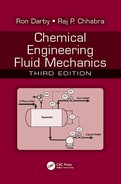The objective of this edition remains the same as that of the first two editions, namely, to present the fundamental (macroscopic) conservation equations that govern the behavior of fluids and to apply these to a wide variety of practical situations of interest to the chemical engineer. Where purely theoretical expressions are not completely adequate to describe the actual fluid system of interest, empirical information is utilized and generalized by principles of similitude where possible.
The general approach to problem solving espoused here is represented by the “baby versus the bathwater” philosophy illustrated in the book. That is, it is believed that the most useful approach to engineering problem solving is to concentrate on those factors that have a major (or significant) influence on the desired solution (i.e., the “baby”) and neglect those that have a negligible or insignificant influence on the answer (i.e., the “bathwater”). The best engineer is the one who is able to recognize the difference between these effects and make the appropriate assumptions in order to achieve the simplest answer that is the most realistic.
Just as in the first two editions, the scope of this edition includes both Newtonian and non- Newtonian incompressible fluids and compressible fluids in subsonic through choked flow. Both internal flows (in pipes, conduits, fittings, etc.) and external flows (fluid drag on particles, sedimentation, fluidization, cyclone separation, etc.) are included.
The chapter on flow measurement has been expanded, the information on drag on nonspherical particles has been expanded, the material on control valves has been completely revised and updated, and a new chapter has been added that includes the sizing of safety relief valves for both single- and two-phase fluids.
A number of examples have been added throughout the book to illustrate the application of the principles. However, it is the authors’ experience that too many students tend to rely on finding a worked problem that represents the problem they are trying to solve and just changing the numbers, rather than starting with the fundamental principles and deriving the solution, which is the desired approach. Thus, a few examples may be good, but too many may actually be detrimental.
This book has found extensive use as both a textbook for students in applied fluid mechanics courses and a useful reference for practicing engineers. It is hoped that this revised edition will also find similar applications for a greater number of readers.
“Engineering is all about tradeoffs.”
“You cannot teach a man anything; you can only help him discover it in himself.”
—Galileo
“In theory there is no difference between theory and practice. In practice there is.”
—Yogi Berra
